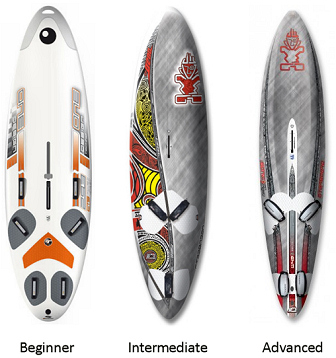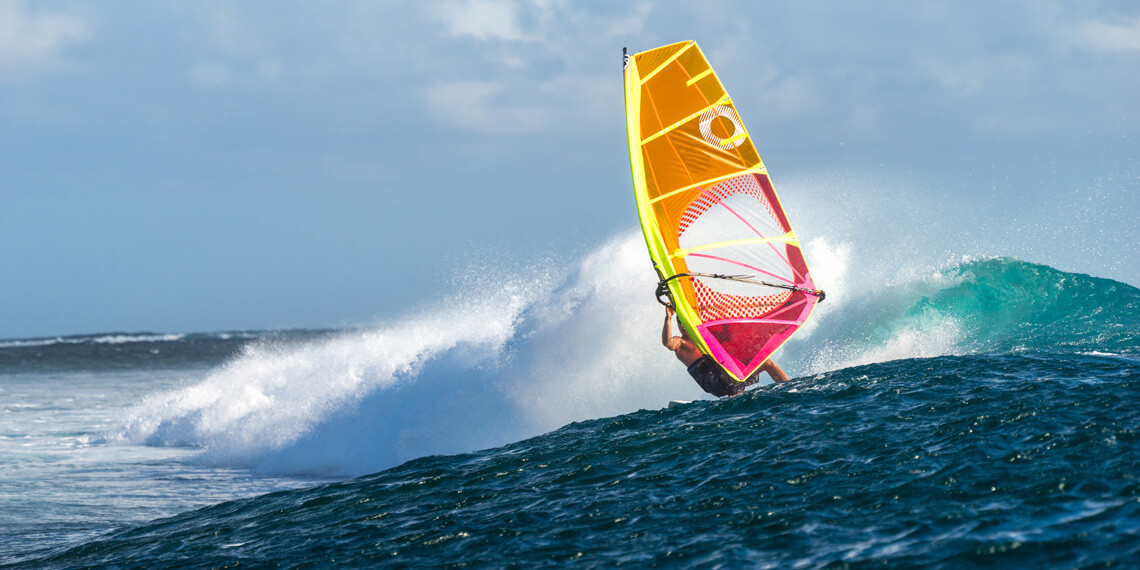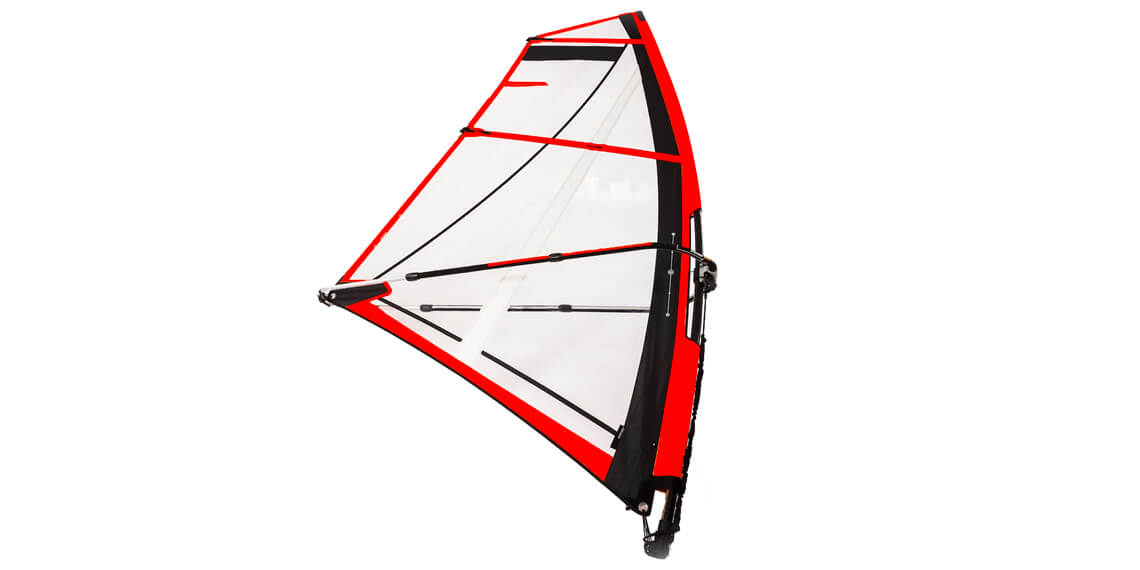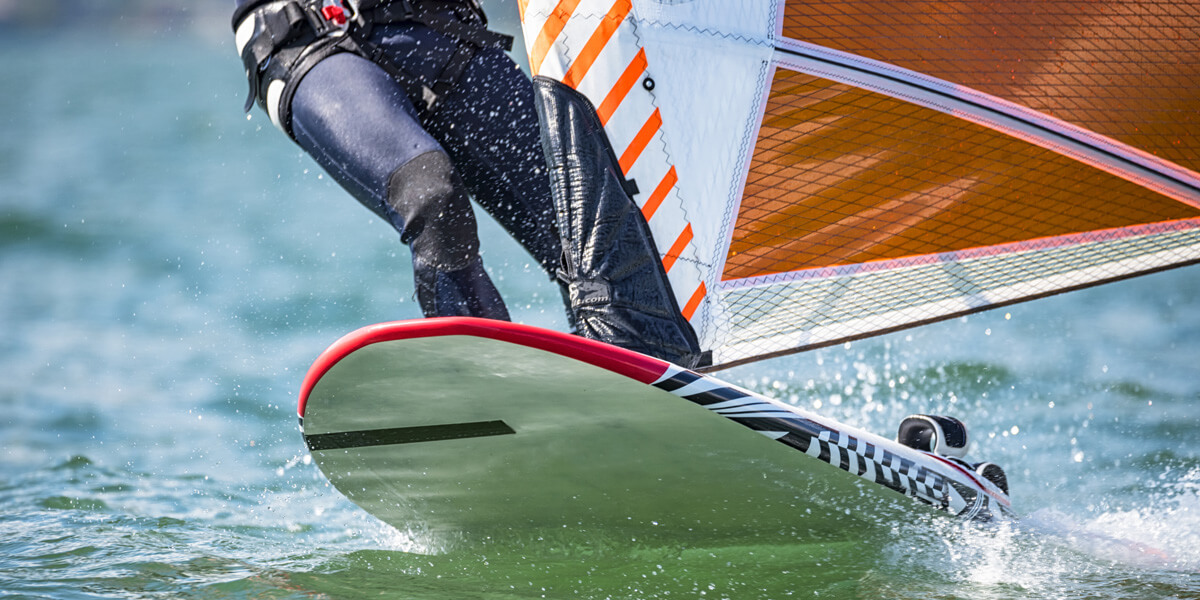You have finally decided to buy yourself a new or your first windsurf board and sail. The problem is: what size? Which board and sail?
Choose the board that fits three important issues: your weight, your level of experience in windsurfing, and the wind speed of your local spot.
There are also other important variables: the width and volume of the board, the material in which the board is made (epoxy, fiberglass, or poly), the type of sail (soft, raft, or camber-induced) and its material (dacron, mylar or monofilm).
Remember, bigger windsurf boards - in terms of volume (liters) - are easier for beginners. Thinner windsurf boards, similar to short surfboards, are more competitive.
Finally, lighter winds require bigger sails. Now, check these windsurf gear tables:
Beginner Windsurf Board
| Rider Weight (kg) | Volume (l) | Length (cm) | Width (cm) |
|---|---|---|---|
| 50 | 145 | 285 | 72 |
| 60 | 160 | 292 | 78 |
| 70 | 175 | 299 | 83 |
| 80 | 190 | 306 | 89 |
| 90 | 205 | 313 | 94 |
| 100 | 220 | 319 | 100 |
| 110 | 235 | 326 | 105 |
| 120 | 250 | 333 | 111 |
Intermediate Windsurf Board
| Rider Weight (kg) | Volume (l) | Length (cm) | Width (cm) |
|---|---|---|---|
| 50 | 95 | 261 | 70 |
| 60 | 108 | 265 | 73 |
| 70 | 121 | 269 | 75 |
| 80 | 134 | 273 | 77 |
| 90 | 147 | 278 | 79 |
| 100 | 160 | 182 | 81 |
| 110 | 173 | 286 | 83 |
| 120 | 186 | 290 | 85 |
How to Choose the Right Windsurf Board?
The Original Windsurfer was a heavy windsurf board.
Meanwhile, the composite industry has evolved and develops lightweight materials that can be found in both beginner and advanced windsurf boards.
Today, a modern sailboard can be made of expanded polystyrene foam, epoxy, fiberglass, PVC, or carbon sandwich.
Windsurf boards are selected by their volume (in liters) and length (in centimeters). High volume boards offer stability and flotation. They are also used in light wind conditions.

The Royal Yachting Association (RYA) developed a fast formula for you to choose the best windsurf board for your sailing needs.
Weight of Rig, Board and Clothing (around 30 kg) + Your Body Weight (in kg) x 2 = Volume of the Board (in liters)
To convert kilograms (kg) to pounds (lb), note that 1 kilogram equals 2.2 pounds. To convert meters (m) to feet (ft), note that 1 meter equals 3.3 feet.
There are four main categories in windsurfing: slalom, speed, freestyle, and wave windsurfing. Each specialty demands specific windsurf boards.
Usually, wave and speed windsurfers prefer lighter boards made of carbon sandwich, while beginners kick off their windsurfing experience with heavier and larger boards.
Speed windsurfing requires short, and light windsurf boards. It's harder to sail on these boards.

How to Pick the Right Windsurf Sail?
The most common windsurfing sails are made of dacron, monofilm, and mylar.
A windsurf sail should be prepared to challenge strong winds, so it requires elasticity, strength, and durability. A stretch-resistant and lightweight sail will perform better and requires fewer repairs.
Dacron usually is applied in sails for beginners. This material is light and cheap.
Mylar is a coated form of Dacron. It holds its shape better but is subject to delamination over time. To strengthen areas of the sail, it is often used Kevlar mesh.
Monofilm is the latest windsurf hype in the sails' market because it holds the shape better than all other materials. The single layer of plastic also allows good visibility. Monofilm is getting very popular in windsurfing.
There are three types of sails: soft, raft, and camber-induced sails.
Get the right windsurfing sail for your weight and current wind speed. The following chart is best viewed on a desktop computer. If needed, rotate your smartphone or table to landscape:
| Rider (kg) | Wind Speed (knots) | 5 | 7 | 10 | 13 | 15 | 20 | 25 | 30 | 35 | 40 |
|---|---|---|---|---|---|---|---|---|---|---|
| 50 | 12.5 m2 | 10.4 m2 | 6.4 m2 | 5.8 m2 | 4.8 m2 | 3.6 m2 | 3.0 m2 | 3.0 m2 | 3.0 m2 | 3.0 m2 |
| 55 | 12.5 m2 | 11.4 m2 | 7.1 m2 | 5.8 m2 | 4.8 m2 | 3.6 m2 | 3.3 m2 | 3.0 m2 | 3.0 m2 | 3.0 m2 |
| 60 | 12.5 m2 | 11.4 m2 | 7.8 m2 | 6.4 m2 | 5.3 m2 | 4.0 m2 | 3.6 m2 | 3.0 m2 | 3.0 m2 | 3.0 m2 |
| 65 | 12.5 m2 | 12.5 m2 | 8.6 m2 | 7.1 m2 | 5.8 m2 | 4.4 m2 | 3.6 m2 | 3.0 m2 | 3.0 m2 | 3.0 m2 |
| 70 | 12.5 m2 | 12.5 m2 | 9.4 m2 | 7.1 m2 | 6.4 m2 | 4.8 m2 | 4.0 m2 | 3.0 m2 | 3.0 m2 | 3.0 m2 |
| 75 | 12.5 m2 | 12.5 m2 | 10.4 m2 | 7.8 m2 | 6.4 m2 | 4.8 m2 | 4.0 m2 | 3.3 m2 | 3.0 m2 | 3.0 m2 |
| 80 | 12.5 m2 | 12.5 m2 | 10.4 m2 | 8.6 m2 | 7.1 m2 | 5.3 m2 | 4.4 m2 | 3.6 m2 | 3.3 m2 | 3.0 m2 |
| 85 | 12.5 m2 | 12.5 m2 | 11.4 m2 | 8.6 m2 | 7.8 m2 | 5.3 m2 | 4.4 m2 | 3.6 m2 | 3.3 m2 | 3.0 m2 |
| 90 | 12.5 m2 | 12.5 m2 | 12.5 m2 | 9.4 m2 | 7.8 m2 | 5.8 m2 | 4.8 m2 | 4.0 m2 | 3.6 m2 | 3.0 m2 |
| 95 | 12.5 m2 | 12.5 m2 | 12.5 m2 | 9.4 m2 | 8.6 m2 | 6.4 m2 | 5.3 m2 | 4.4 m2 | 3.6 m2 | 3.3 m2 |
| 100 | 12.5 m2 | 12.5 m2 | 12.5 m2 | 10.4 m2 | 9.4 m2 | 6.4 m2 | 5.3 m2 | 4.4 m2 | 4.0 m2 | 3.3 m2 |
| 105 | 12.5 m2 | 12.5 m2 | 12.5 m2 | 11.4 m2 | 9.4 m2 | 7.1 m2 | 5.8 m2 | 4.8 m2 | 4.0 m2 | 3.6 m2 |
| 110 | 12.5 m2 | 12.5 m2 | 12.5 m2 | 11.4 m2 | 10.4 m2 | 7.1 m2 | 5.8 m2 | 4.8 m2 | 4.4 m2 | 3.6 m2 |
| 115 | 12.5 m2 | 12.5 m2 | 12.5 m2 | 12.5 m2 | 11.4 m2 | 7.8 m2 | 6.4 m2 | 5.3 m2 | 4.4 m2 | 3.6 m2 |
| 120 | 12.5 m2 | 12.5 m2 | 12.5 m2 | 12.5 m2 | 11.4 m2 | 7.8 m2 | 6.4 m2 | 5.3 m2 | 4.4 m2 | 4.0 m2 |

Learn to windsurf in two hours. Take a look at the best anemometers in the world.
Learn how to make your own windsurfing sail. Discover how to rig a windsurfing sail properly.
